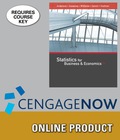
western University has only one women’s softball scholarship remaining for the coming year. The final two players that western is considering are Allison fealey and Emily Janson. The coaching staff has concluded that the speed and defensive skills are virtually identical for the two players, and that the final decision will be based on which player has the best batting average. Crosstabulations of each player’s batting performance in their junior and senior years of high school are as follows:

A player’s batting average is computed by dividing the number of hits a player has by the total number of at-bats. batting averages are represented as a decimal number with three places after the decimal.
a. Calculate the batting average for each player in her junior year. Then calculate the batting average of each player in her senior year. Using this analysis, which player should be awarded the scholarship? Explain.
b. Combine or aggregate the data for the junior and senior years into one crosstabulation as follows:
| Player | ||
| Outcome | Fealey | Jamon |
| Hit No Hit | ||
| Total At-Bats | ||
Calculate each player’s batting average for the combined two years. Using this analysis, which player should be awarded the scholarship? Explain.
c. Are the recommendations you made in parts (a) and (b) consistent? Explain any apparent inconsistencies.
Trending nowThis is a popular solution!

Chapter 2 Solutions
CENGAGENOW FOR ANDERSON/SWEENEY/WILLIAM
- During busy political seasons, many opinion polls are conducted. In apresidential race, how do you think the participants in polls are generally selected?Discuss any issues regarding simple random, stratified, systematic, cluster, andconvenience sampling in these polls. What about other types of polls, besides political?arrow_forwardPlease could you explain why 0.5 was added to each upper limpit of the intervals.Thanksarrow_forward28. (a) Under what conditions do we say that two random variables X and Y are independent? (b) Demonstrate that if X and Y are independent, then it follows that E(XY) = E(X)E(Y); (e) Show by a counter example that the converse of (ii) is not necessarily true.arrow_forward
- 19. Let X be a non-negative random variable. Show that lim nE (IX >n)) = 0. E lim (x)-0. = >arrow_forward(c) Utilize Fubini's Theorem to demonstrate that E(X)= = (1- F(x))dx.arrow_forward(c) Describe the positive and negative parts of a random variable. How is the integral defined for a general random variable using these components?arrow_forward
 Glencoe Algebra 1, Student Edition, 9780079039897...AlgebraISBN:9780079039897Author:CarterPublisher:McGraw Hill
Glencoe Algebra 1, Student Edition, 9780079039897...AlgebraISBN:9780079039897Author:CarterPublisher:McGraw Hill Big Ideas Math A Bridge To Success Algebra 1: Stu...AlgebraISBN:9781680331141Author:HOUGHTON MIFFLIN HARCOURTPublisher:Houghton Mifflin Harcourt
Big Ideas Math A Bridge To Success Algebra 1: Stu...AlgebraISBN:9781680331141Author:HOUGHTON MIFFLIN HARCOURTPublisher:Houghton Mifflin Harcourt


